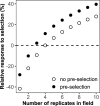The value of early root development traits in breeding programs for biomass yield in perennial ryegrass (Lolium perenne L.)
- PMID: 39836302
- PMCID: PMC11750904
- DOI: 10.1007/s00122-024-04797-5
The value of early root development traits in breeding programs for biomass yield in perennial ryegrass (Lolium perenne L.)
Abstract
Early root traits, particularly total root length, are heritable and show positive genetic correlations with biomass yield in perennial ryegrass; incorporating them into breeding programs can enhance genetic gain. Perennial ryegrass (Lolium perenne L.) is an important forage grass widely used in pastures and lawns, valued for its high nutritive value and environmental benefits. Despite its importance, genetic improvements in biomass yield have been slow, mainly due to its outbreeding nature and the challenges of improving multiple traits simultaneously. This study aims to assess the potential advantages of including early root traits in the perennial ryegrass breeding process. Root traits, including total root length (TRL) and root angle (RA) were phenotyped in a greenhouse using rhizoboxes, and genetic correlations with field yield were estimated across three European locations over two years. Bivariate models estimated significant genetic correlations of 0.40 (SE = 0.14) between TRL and field yield, and a weak but positive correlation to RA of 0.15 (SE = 0.14). Heritability estimates were 0.36 for TRL, 0.39 for RA, and 0.31 for field yield across locations. Incorporating root trait data into selection criteria can improve the efficiency of breeding programs, potentially increasing genetic gain by approximately 10%. This results highlight the potential of early root traits to refine selection criteria in perennial ryegrass breeding programs, contributing to higher yield and efficiency.
© 2025. The Author(s).
Conflict of interest statement
Declarations. Conflict of interest: The authors have no relevant financial or non-financial interests to disclose.
Figures




Similar articles
-
Developing an integrated genomic selection approach beyond biomass for varietal protection and nutritive traits in perennial ryegrass (Lolium perenne L.).Theor Appl Genet. 2023 Mar 10;136(3):44. doi: 10.1007/s00122-023-04263-8. Theor Appl Genet. 2023. PMID: 36897387 Free PMC article.
-
Exploitation of data from breeding programs supports rapid implementation of genomic selection for key agronomic traits in perennial ryegrass.Theor Appl Genet. 2018 Sep;131(9):1891-1902. doi: 10.1007/s00122-018-3121-7. Epub 2018 Jun 2. Theor Appl Genet. 2018. PMID: 29860624 Free PMC article.
-
An investigation of genotype-phenotype association in a festulolium forage grass population containing genome-spanning Festuca pratensis chromosome segments in a Lolium perenne background.PLoS One. 2018 Nov 14;13(11):e0207412. doi: 10.1371/journal.pone.0207412. eCollection 2018. PLoS One. 2018. PMID: 30427919 Free PMC article.
-
Evaluating the use of plant hormones and biostimulators in forage pastures to enhance shoot dry biomass production by perennial ryegrass (Lolium perenne L.).J Sci Food Agric. 2016 Feb;96(3):715-26. doi: 10.1002/jsfa.7238. Epub 2015 May 22. J Sci Food Agric. 2016. PMID: 25919035 Review.
-
Insights into the Response of Perennial Ryegrass to Abiotic Stress: Underlying Survival Strategies and Adaptation Mechanisms.Life (Basel). 2022 Jun 8;12(6):860. doi: 10.3390/life12060860. Life (Basel). 2022. PMID: 35743891 Free PMC article. Review.
References
-
- Adeleke E, Millas R, McNeal W, Faris JD, Taheri A (2020) Variation analysis of root system development in wheat seedlings using root phenotyping system. Agronomy. 10.3390/agronomy10020206
-
- Bai C, Ge Y, Ashton RW, Evans J, Coleman K, Milne AE, Hawkesford MJ, Whalley WR, Parry MAJ, Melichar J, Feuerhelm D, Basler PB, Bartsch M (2019) The relationships between seedling root screens, root growth in the field and grain yield for wheat. Plant Soil. 10.1007/s11104-019-04088-9
-
- Bednar-Friedl, B, Biesbroek, R, Schmidt, DN, Alexander, P, Børsheim, KY, Carnicer, J, Georgopoulou, E, Haasnoot, M, Le Cozzanet, G, Lionello, P, et al (2022) Europe (Chapter 13), in: IPCC 2022: Climate change 2022: impacts, adaptation and vulnerability. Contribution of working group II to the sixth assessment report of the intergovernmental panel on climate change. Cambridge University Press, Cambridge and New York, pp 1817–1927
MeSH terms
Grants and funding
LinkOut - more resources
Full Text Sources

